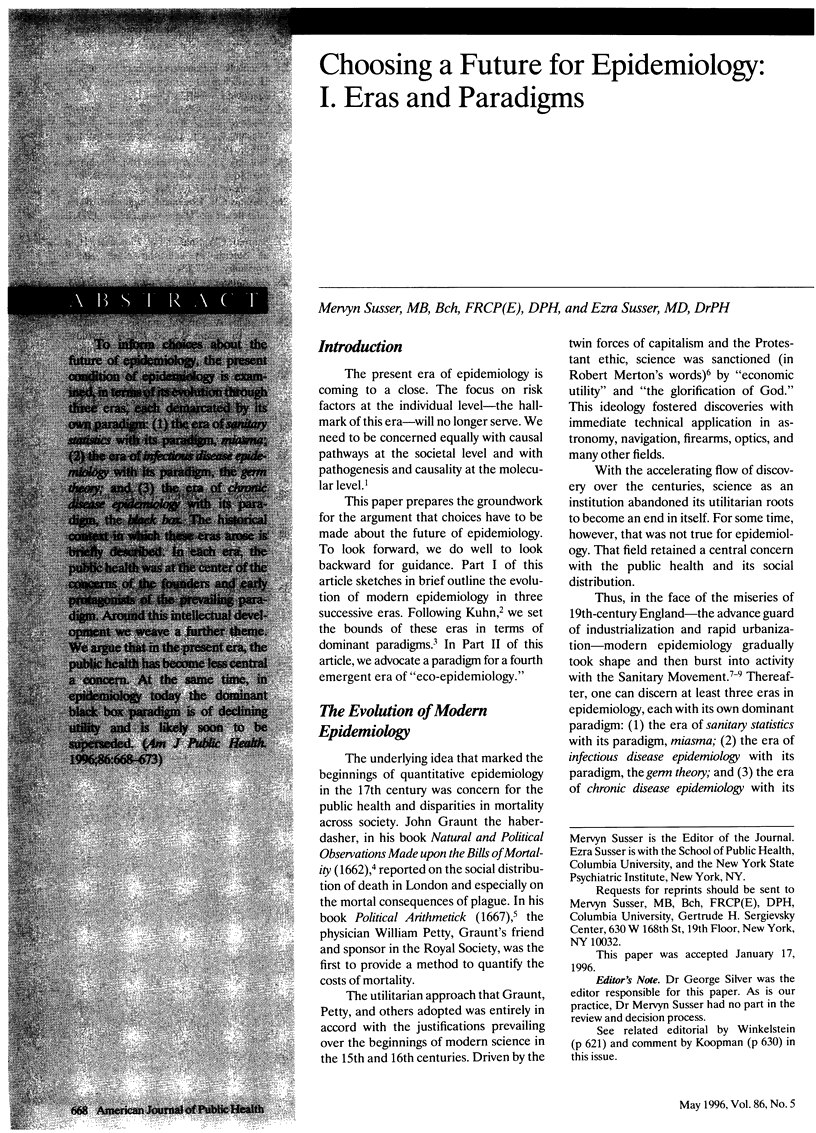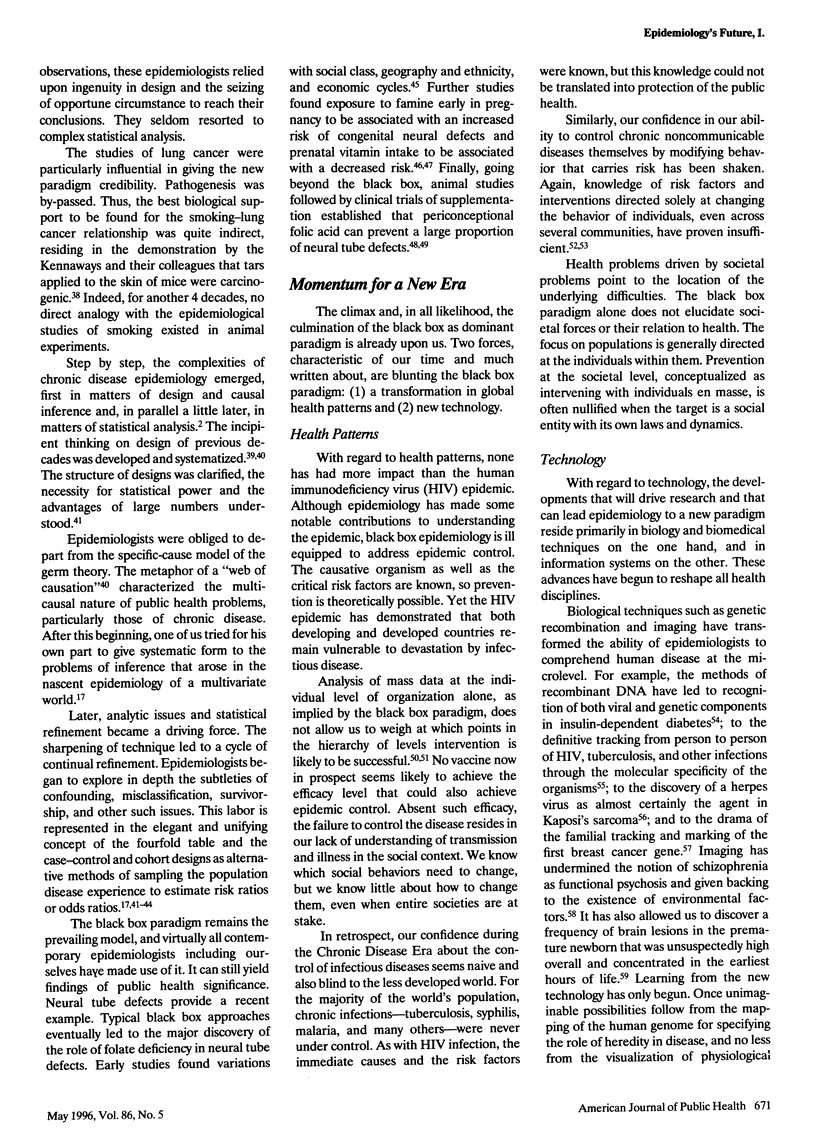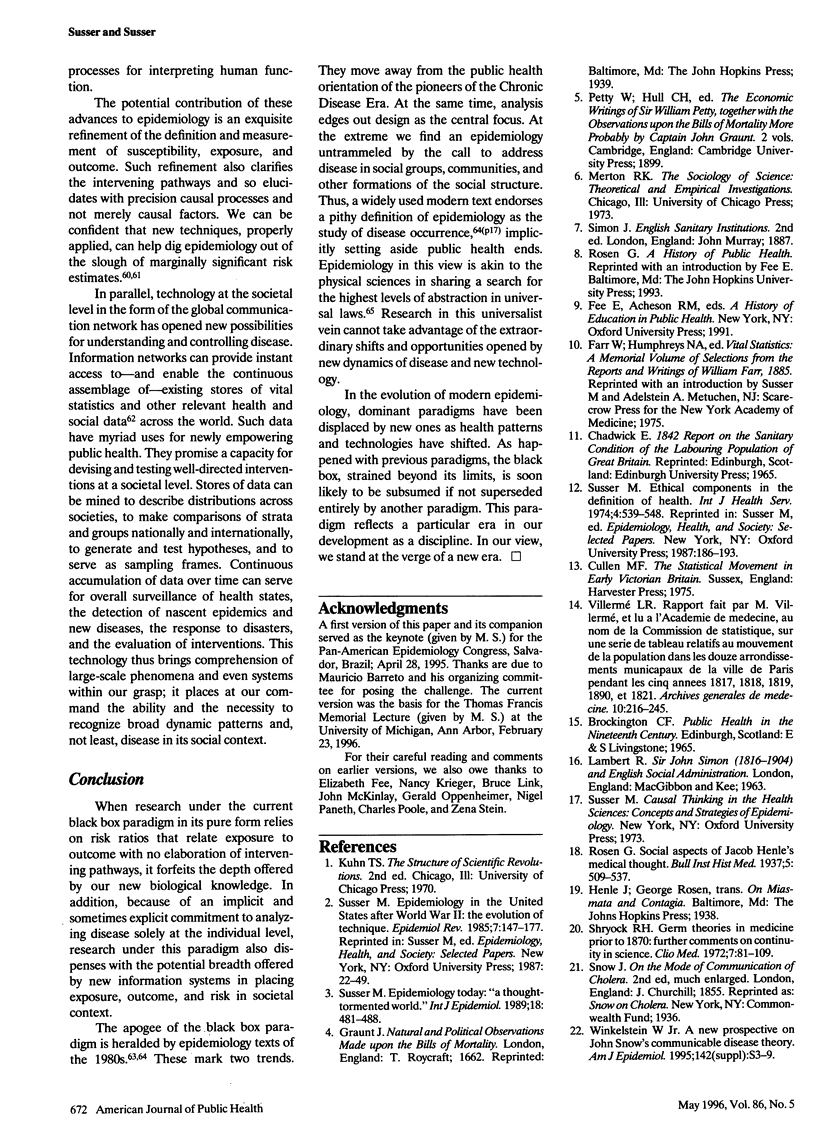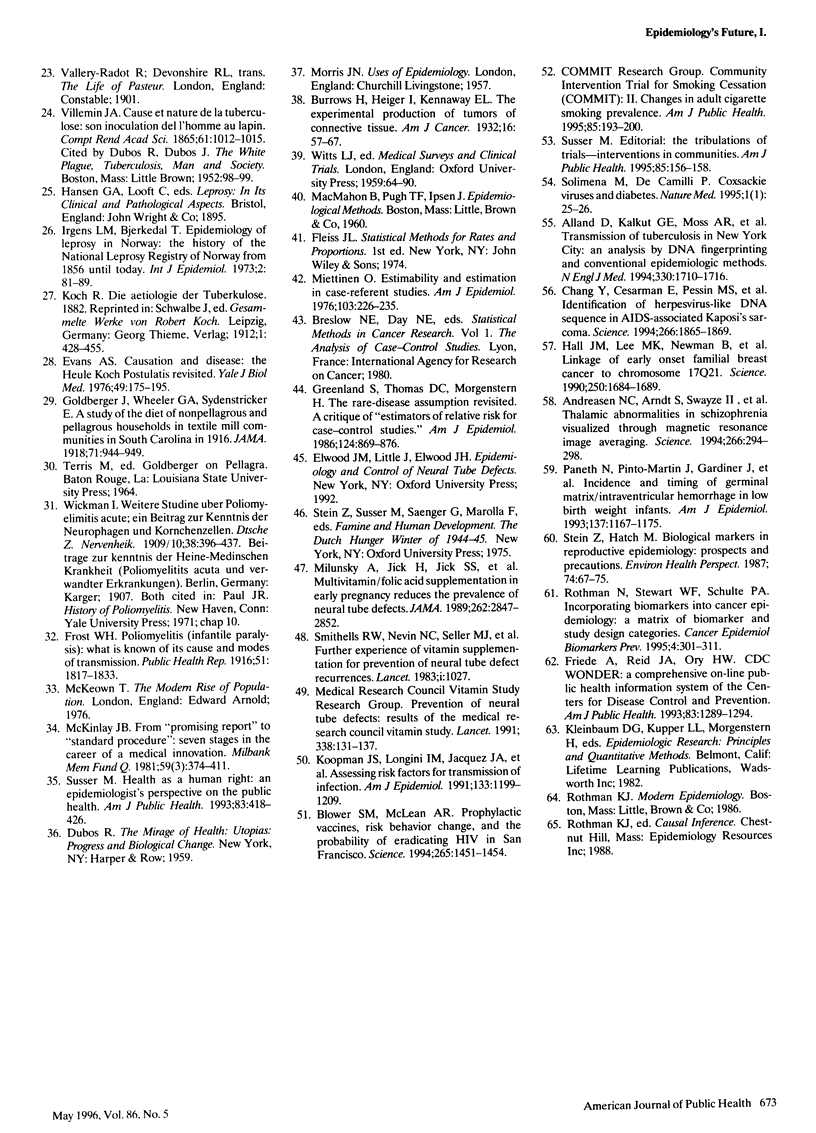Abstract
To inform choices about the future of epidemiology, the present condition of epidemiology is examined, in terms of its evolution through three eras, each demarcated by its own paradigm: (1) the era of sanitary statistics with its paradigm, miasma; (2) the era of infectious disease epidemiology with its paradigm, the germ theory; and (3) the era of chronic disease epidemiology with its paradigm, the black box. The historical context in which these eras arose is briefly described. In each era, the public health was at the center of the concerns of the founders and early protagonists of the prevailing paradigm. Around this intellectual development we weave a further theme. We argue that in the present era, the public health has become less central a concern. At the same time, in epidemiology today the dominant black box paradigm is of declining utility and is likely soon to be superseded.
Full text
PDF





Selected References
These references are in PubMed. This may not be the complete list of references from this article.
- Alland D., Kalkut G. E., Moss A. R., McAdam R. A., Hahn J. A., Bosworth W., Drucker E., Bloom B. R. Transmission of tuberculosis in New York City. An analysis by DNA fingerprinting and conventional epidemiologic methods. N Engl J Med. 1994 Jun 16;330(24):1710–1716. doi: 10.1056/NEJM199406163302403. [DOI] [PubMed] [Google Scholar]
- Andreasen N. C., Arndt S., Swayze V., 2nd, Cizadlo T., Flaum M., O'Leary D., Ehrhardt J. C., Yuh W. T. Thalamic abnormalities in schizophrenia visualized through magnetic resonance image averaging. Science. 1994 Oct 14;266(5183):294–298. doi: 10.1126/science.7939669. [DOI] [PubMed] [Google Scholar]
- Blower S. M., McLean A. R. Prophylactic vaccines, risk behavior change, and the probability of eradicating HIV in San Francisco. Science. 1994 Sep 2;265(5177):1451–1454. doi: 10.1126/science.8073289. [DOI] [PubMed] [Google Scholar]
- Chang Y., Cesarman E., Pessin M. S., Lee F., Culpepper J., Knowles D. M., Moore P. S. Identification of herpesvirus-like DNA sequences in AIDS-associated Kaposi's sarcoma. Science. 1994 Dec 16;266(5192):1865–1869. doi: 10.1126/science.7997879. [DOI] [PubMed] [Google Scholar]
- Evans A. S. Causation and disease: the Henle-Koch postulates revisited. Yale J Biol Med. 1976 May;49(2):175–195. [PMC free article] [PubMed] [Google Scholar]
- Friede A., Reid J. A., Ory H. W. CDC WONDER: a comprehensive on-line public health information system of the Centers for Disease Control and Prevention. Am J Public Health. 1993 Sep;83(9):1289–1294. doi: 10.2105/ajph.83.9.1289. [DOI] [PMC free article] [PubMed] [Google Scholar]
- Greenland S., Thomas D. C., Morgenstern H. The rare-disease assumption revisited. A critique of "estimators of relative risk for case-control studies". Am J Epidemiol. 1986 Dec;124(6):869–883. doi: 10.1093/oxfordjournals.aje.a114476. [DOI] [PubMed] [Google Scholar]
- Hall J. M., Lee M. K., Newman B., Morrow J. E., Anderson L. A., Huey B., King M. C. Linkage of early-onset familial breast cancer to chromosome 17q21. Science. 1990 Dec 21;250(4988):1684–1689. doi: 10.1126/science.2270482. [DOI] [PubMed] [Google Scholar]
- Irgens L. M., Bjerkedal T. Epidemiology of leprosy in Norway: the history of The National Leprosy Registry of Norway from 1856 until today. Int J Epidemiol. 1973 Spring;2(1):81–89. doi: 10.1093/ije/2.1.81. [DOI] [PubMed] [Google Scholar]
- Koopman J. S., Longini I. M., Jr, Jacquez J. A., Simon C. P., Ostrow D. G., Martin W. R., Woodcock D. M. Assessing risk factors for transmission of infection. Am J Epidemiol. 1991 Jun 15;133(12):1199–1209. doi: 10.1093/oxfordjournals.aje.a115832. [DOI] [PubMed] [Google Scholar]
- McKinlay J. B. From "promising report" to "standard procedure": seven stages in the career of a medical innovation. Milbank Mem Fund Q Health Soc. 1981 Summer;59(3):374–411. [PubMed] [Google Scholar]
- Miettinen O. Estimability and estimation in case-referent studies. Am J Epidemiol. 1976 Feb;103(2):226–235. doi: 10.1093/oxfordjournals.aje.a112220. [DOI] [PubMed] [Google Scholar]
- Milunsky A., Jick H., Jick S. S., Bruell C. L., MacLaughlin D. S., Rothman K. J., Willett W. Multivitamin/folic acid supplementation in early pregnancy reduces the prevalence of neural tube defects. JAMA. 1989 Nov 24;262(20):2847–2852. doi: 10.1001/jama.262.20.2847. [DOI] [PubMed] [Google Scholar]
- Paneth N., Pinto-Martin J., Gardiner J., Wallenstein S., Katsikiotis V., Hegyi T., Hiatt I. M., Susser M. Incidence and timing of germinal matrix/intraventricular hemorrhage in low birth weight infants. Am J Epidemiol. 1993 Jun 1;137(11):1167–1176. doi: 10.1093/oxfordjournals.aje.a116619. [DOI] [PubMed] [Google Scholar]
- Rothman N., Stewart W. F., Schulte P. A. Incorporating biomarkers into cancer epidemiology: a matrix of biomarker and study design categories. Cancer Epidemiol Biomarkers Prev. 1995 Jun;4(4):301–311. [PubMed] [Google Scholar]
- Shryock R. H. Germ theories in medicine prior to 1870: further comments on continuity in science. Clio Med. 1972 Mar;7(1):81–109. [PubMed] [Google Scholar]
- Smithells R. W., Nevin N. C., Seller M. J., Sheppard S., Harris R., Read A. P., Fielding D. W., Walker S., Schorah C. J., Wild J. Further experience of vitamin supplementation for prevention of neural tube defect recurrences. Lancet. 1983 May 7;1(8332):1027–1031. doi: 10.1016/s0140-6736(83)92654-5. [DOI] [PubMed] [Google Scholar]
- Solimena M., De Camilli P. Coxsackieviruses and diabetes. Nat Med. 1995 Jan;1(1):25–26. doi: 10.1038/nm0195-25. [DOI] [PubMed] [Google Scholar]
- Stein Z., Hatch M. Biological markers in reproductive epidemiology: prospects and precautions. Environ Health Perspect. 1987 Oct;74:67–75. doi: 10.1289/ehp.877467. [DOI] [PMC free article] [PubMed] [Google Scholar]
- Susser M. Epidemiology in the United States after World War II: the evolution of technique. Epidemiol Rev. 1985;7:147–177. doi: 10.1093/oxfordjournals.epirev.a036280. [DOI] [PubMed] [Google Scholar]
- Susser M. Epidemiology today: 'a thought-tormented world'. Int J Epidemiol. 1989 Sep;18(3):481–488. doi: 10.1093/ije/18.3.481. [DOI] [PubMed] [Google Scholar]
- Susser M. Ethical components in the definition of health. Int J Health Serv. 1974 Summer;4(3):539–548. doi: 10.2190/BHAK-HYLB-0EPJ-X5XA. [DOI] [PubMed] [Google Scholar]
- Susser M. Health as a human right: an epidemiologist's perspective on the public health. Am J Public Health. 1993 Mar;83(3):418–426. doi: 10.2105/ajph.83.3.418. [DOI] [PMC free article] [PubMed] [Google Scholar]
- Susser M. The tribulations of trials--intervention in communities. Am J Public Health. 1995 Feb;85(2):156–158. doi: 10.2105/ajph.85.2.156. [DOI] [PMC free article] [PubMed] [Google Scholar]
- Winkelstein W., Jr A new perspective on John Snow's communicable disease theory. Am J Epidemiol. 1995 Nov 1;142(9 Suppl):S3–S9. doi: 10.1093/aje/142.supplement_9.s3. [DOI] [PubMed] [Google Scholar]


